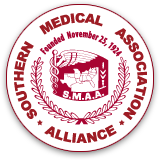SMAA: Medical Heritage
Medical Heritage – A Southern Tradition


Medical Heritage is the oldest continuing project of the SMA Alliance, going back to the 1930 presidential acceptance speech of Mrs. S. A. Collum of Texas. “It has occurred to me that you might like to gather the medical romances of our Southland and publish them in a form presentable to school children” she said. A Research Committee was formed and began enthusiastically to gather many “medical romances“, or biographical sketches of outstanding physicians. The Alliance voted to publish and distribute them to schools and libraries in the Southern region.
In 1934 the SMA Journal agreed to publish in each issue a short biography of a medical “hero” from each member state in turn. 1935 saw the forerunner of our “access file,” a small printed booklet listing all the collected papers. These could be borrowed for use as programs. By 1936 the term Romance had become attached to the Research Committee, which was known as “Research and Romance” for the next 50 years.
The Alliance’s scholarly efforts were impressive. By 1949 it was necessary to buy a steel file to hold all the collected papers, which were shipped each year from chairman to chairman along with books and pamphlets, until permanent space was finally provided at the SMA headquarters.
A 1949 pamphlet, updated for a decade, listed the accumulated studies under the title “Suggestive Programs for the Woman’s Auxiliaries to the County Medical Societies“.
By the 1960’s, the practice of exhibiting projects at the annual meeting had begun, and in 1968 the Dr. and Mrs. Milford O. Rouse Trophy was first given for the most outstanding exhibit of Research and Romance of Medicine material.
In 1973 a committee was appointed to produce a handbook which, when printed in 1976, was packed with detailed information on terms, criteria, categories, prizes and forms. It also outlined the SMA Alliance’s committee structure for “Research and Romance”. The 1982 revision of this handbook showed the Alliance still giving cash prizes or $10 for first place in each category, with honorable mention for second place. The winner of the Rouse Trophy also got $10, and special certificates went to authors of books promoted by individual Alliances.
In 1986 the SMA Alliance changed the project name to Medical Heritage (Research and Romance), and the handbook was completely revised. In 1993 new Bylaws were adopted changing the structure of SMAA, and a committee revised the guidelines for Medical Heritage. The current handbook is based on several years experience with those guidelines.
Project Criteria
All studies and projects must:
- relate to events or activities within, or relative to, the region of the Southern Medical Association.
- be material not previously exhibited. “Redbooks” submitted should clearly show what information is new.
State Projects:
Each state may enter one state project per year. To qualify as a state project, the project must:
1. represent three or more counties in the state, or
2.be worked on by people from several counties, or
3.be on a state-wide institution or organization, or
4.be a multi-county survey of some type of institution.
It may also qualify if it will be made available to citizens of the entire state through a museum or etc.
County Projects:
Every county in each member state is entitled to enter one project per year. These will be judged in three size catagories based on number of county members.
If your project needs funding: Contact your state Medical Heritage Councilor. SMA generously provides an annual financial allotment for each state, and your Councilor may be able to allot some of it to you.
PREPARING THE PROJECT FOR PRESENTATION
One or more of the following methods for presenting a project may be used. However, winners will not be chosen for the number of methods used, but for the best project.
Methods of Presentation include:
- Books, Manuscripts, poems, or brochures.
- If not written by Auxiliary member, indicate any Auxiliary role in promoting or publicizing;
- Video or audio tapes, or slide presentations
- Scrapbooks and/or Poster displays of pictures/articles
- Redbooks
A Redbook is a red scrapbook that documents medical history through pictures, articles, etc. and is kept up-to-date by a state or county auxiliary/alliance and submitted periodically for judging. Only material added since the last submission can be judged, and must be clearly marked for the judges.
Whatever method is chosen, all exhibits must fit into a 36 inch x 36 inch x 36 inch space.
Folding Exhibit Boards (1/4 ” too high, but acceptable!) are available from the SMAA office for a nominal charge (see p. 10) or you may develop your own display.
Submitting Your Project
- Inform your state Councilor for Medical Heritage regarding your interest. Your Councilor can supply you with the official entry form, and advise you on deadlines, transporting your exhibit to the Annual Meeting, any state competitions, etc. Entry form are also available directly from Auxiliary headquarters (see p. 8).
- For a project to be judged, the official entry form with written summary must be submitted to SMA Auxiliary Headquarters by (July 1). Each entrant will be sent a few simple follow-up steps for displaying the project at the SMAA Convention. Only projects which have complied with the above deadlines and regulations will be eligible for awards.
HOW WILL THE PROJECTS BE JUDGED?
An Auxiliary judging committee will review all project entries prior to Convention, and then examine each project at Convention. Judges will base their decisions on the following:
a. Thoroughness of description of project;
b. Quality of documentation and research and how well it is presented;
c. Quality of over-all planning and how well carried out;
d. Visual appeal, how understandably presented;
e. Suitability of methods of presentation chosen.
ANNUAL AWARDS
1. Certificates and ribbons (first, second and third place) are given for each of the following catagories:
a. State exhibits
b. Exhibits from counties with over 150 members.
c. Exhibits from counties of 75 to 150 members
d. Exhibits from counties with less than 75 members
2. The Dr. and Mrs. Milford O. Rouse Award is given for the most outstanding project, whether from a county or state.
3. Special commendation awards may be given.
A book will be kept at SMAA Headquarters in which the names of the award winners will be inscribed each year.
